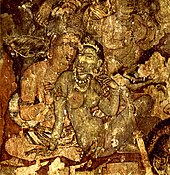e Deccan Plateau, archaeological evidence from this period suggests the existence of a chiefdom stage of political organisation.[36] In southern India, a progression to sedentary life is indicated by the large number of megalithic monuments dating from this period,[42] as well as by nearby traces of agriculture, irrigation tanks, and craft traditions.[42]
In the late Vedic period, around the 6th century BCE, the small states and chiefdoms of the Ganges Plain and the north-western regions had consolidated into 16 major oligarchies and monarchies that were known as the mahajanapadas.[43][44] The emerging urbanisation gave rise to non-Vedic religious movements, two of which became independent religions. Jainism came into prominence during the life of its exemplar, Mahavira.[45] Buddhism, based on the teachings of Gautama Buddha attracted followers from all social classes excepting the middle class; chronicling the life of the Buddha was central to the beginnings of recorded history in India.[46][47][48] In an age of increasing urban wealth, both religions held up renunciation as an ideal,[49] and both established long-lasting monastic traditions. Politically, by the 3rd century BCE, the kingdom of Magadha had annexed or reduced other states to emerge as the Mauryan Empire.[50]The empire was once thought to have controlled most of the subcontinent excepting the far south, but its core regions are now thought to have been separated by large autonomous areas.[51][52] The Mauryan kings are known as much for their empire-building and determined management of public life as for Ashoka's renunciation of militarism and far-flung advocacy of the Buddhist dhamma.[53][54]
The Sangam literature of the Tamil language reveals that, between 200 BCE and 200 CE, the southern peninsula was being ruled by the Cheras, the Cholas, and the Pandyas, dynasties that traded extensively with the Roman Empire and with West and South-East Asia.[55][56] In North India, Hinduism asserted patriarchal control within the family, leading to increased subordination of women.[57][50] By the 4th and 5th centuries, the Gupta Empire had created in the greater Ganges Plain a complex system of administration and taxation that became a model for later Indian kingdoms.[58][59] Under the Guptas, a renewed Hinduism based on devotion rather than the management of ritual began to assert itself.[60] The renewal was reflected i

